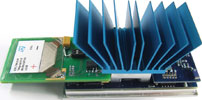

STMicroelectronics and Micropelt, a nascent German company specialising in novel thin film thermoelectric devices, have announced a jointly-developed autonomous wireless sensor evaluation kit. The TE-Power NODE evaluation kit combines Micropelt’s Thermogenerator and ST’s EnFilm solid-state thin-film battery as energy storage for power backup and pulse current.
Power management and charge monitoring circuitry connect to the included graphical user interface software via a 2,4 GHz wireless link.
Energy harvesting, in which useful electrical energy is generated from freely available sources such as vibration, heat or light, is an essential part of building self-powered wireless sensors that do not require battery maintenance. Today, there is a growing trend towards the use of wireless sensor networks, particularly in applications such as process automation, condition monitoring and smart buildings. While these wireless sensor networks produce immediate benefits, including the avoidance of costly wiring of sensors and easy deployment in previously inaccessible locations, a truly ‘intelligent environment’ approach envisages a large number of sensors mounted at every useful measurement point. The sensors measure parameters such as temperature, pressure or vibration, and send this data wirelessly to a control or monitoring system. The information is then used for better process control and energy management, lower maintenance cost and more efficient buildings.
At the heart of the new evaluation kit, a thermoelectric generator (TEG) exploits a physical phenomenon known as the Seebeck effect, in which electric power results from the heat flux produced by a temperature differential across a thermoelectric micro-structured layer. From an effective gradient of 10°C, the TEG generates a voltage of 1,4 V. Micropelt’s custom power conditioning converts this into sufficient power to drive the wireless sensor node and charge a battery using excess thermal energy. In the TE-Power NODE evaluation kit, the Micropelt TEG MPG-D751 is housed between a solid aluminium base plate and a finned heatsink. The base is attached to a suitable heat source, so the cooling effect of the heatsink can create a temperature differential across the embedded TEG.
The rechargeable battery used in the kit is ST’s EFL700A39 EnFilm thin film solid state battery, a 700 microamp-hour, UL1642-certified rechargeable battery that can deliver high pulsed peak current (up to 10 mA) to provide power to the wireless sensor node during its communication with the network. When the base plate of the evaluation kit is in contact with a heat source, the Micropelt TEG provides power to the system and recharges the EnFilm. When the heat source is removed, the TEG stops and only the EnFilm battery provides power to the wireless sensor. The combination of TEG and EnFilm battery balances thermal supply gaps and establishes a virtually perpetual energy supply to the attached wireless system.
The battery board, designed by ST, contains the EnFilm battery and the electronic circuitry that controls and monitors both battery charge level and the energy balance. The board includes a BiCMOS linear regulator (STLQ50) specifically designed for operating in environments with very low power consumption constraints, as well as the STC3100 battery management chip, which monitors battery voltage, current and temperature. The circuitry also incorporates a Coulomb counter to keep track of the charge/discharge status.
The wireless sensor module included in the evaluation kit was designed by Micropelt to establish a versatile low-power link to its graphical user interface named TE-Power SCOPE. The software displays and logs essential thermal and electrical system parameters, including a continuously measured power balance between the TEG and the EnFilm battery. To the user this setup provides a means to assess the performance of the EnFilm-buffered thermoharvester in an intended application, facilitating system design and speeding time to market.
For more information contact Robin Scholes, Avnet Kopp, +27 (0)11 809 6100, [email protected], www.avnet.co.za

© Technews Publishing (Pty) Ltd | All Rights Reserved